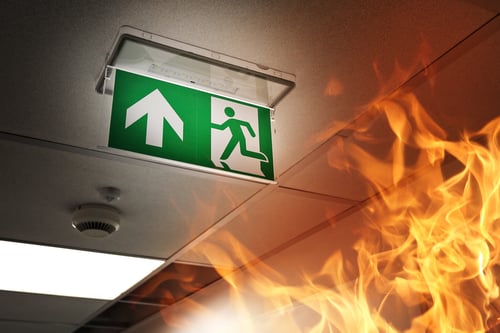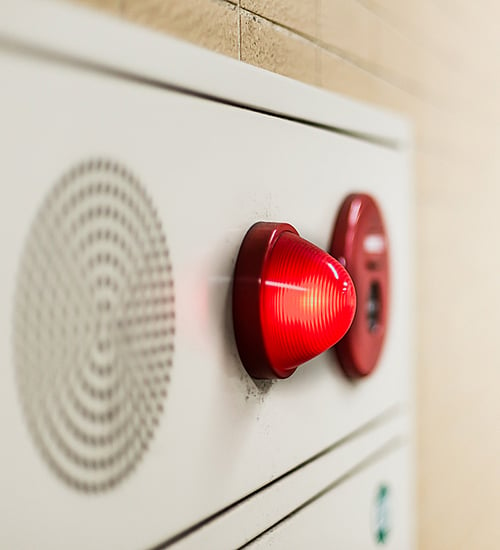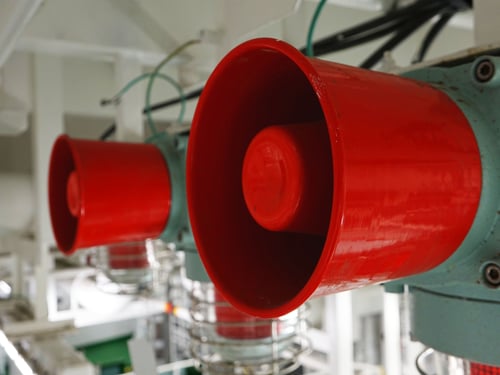Mass Notification System Design
Our MNS design meet all the requirements for compliant, effective systems that will respond to the full range of signals.
Our MSN design incorporates emergency communications systems that provide warnings and information that save lives.
Our solutions cater for specific circumstances ranging from high-rise buildings that accommodate businesses to military bases.

Mass notification systems (MNS) are used to provide people in buildings and other spaces with information and instructions when there is an emergency of some sort. They are designed to utilize various emergency communications systems including intelligible voice communications and visual signals. MNS include in-building fire emergency communications that incorporate voice and alarm systems as well as in-building and wide-area mass notification systems. These are all discussed in more detail later on.
Mass notification systems were originally set up as military solutions, but are now part and parcel of emergency communications systems.

Control units are system components that monitor inputs and control outputs though different types of circuits. These include emergency communications control units (ECCU) that can send mass notification messages to individuals buildings as well as zones of buildings, individual outdoor loudspeakers or zones of loudspeaker arrays, or outside areas, a single building, multiple buildings, or a combination of these.
Autonomous control units (ACU) are primary control units that are an essential part of in-building mass notification systems.
Additionally, there are fire alarm control units (FACU) and wireless control units that transmit, receive, and process wireless signals.
FACUs are important components of fire alarm systems and they are fundamental to mass notification system design. Provided with both primary and secondary power sources, FACUs receive signals from initiating devices that originate transmit of a change-of-state condition, for instance, a manual fire alarm box, a smoke detector, or a supervisory switch. They might also receive signals from other FACUs. The unit is designed to process these signals to determine required output functions.
There are four FACUs that are specified and therefore regulated by the National Fire Protection Association (NFPA) National Fire Alarm and Signaling Code NFPA 72.

Emergency communications systems are designed to warn people of emergency situations and communicate information that is needed to facilitate an appropriate response and action and in this way protect life and property.
NFPA 72 specifies six emergency communications systems but acknowledges that often a combination of systems are served via a single control system or through the interconnection of several systems. These commonly include fire alarms, mass notification systems, elevator communications, areas of refuge communications, and firefighter communications.
Individually defined systems are:
It stands to reason, therefore, that this type of emergency communication system is used to both communicate and exchange information including instructions, conditions of the local environment, the condition of people (including those in areas of refuge), acknowledgment of messages received, and importantly, to assure everyone that help is on the way.
When engineers design fire alarm systems, we identify certain zones which are defined areas within protected premises. These may be areas from which signals can be received, areas where signals can be sent, or areas where a specified form of control can be executed.
Notification zones are defined areas inside or outside buildings where people congregate to receive common notifications.
Sometimes fire alarm systems are used to assist with partial evacuation and relocation of occupants in an affected building. When this is a requirement it is essential that the system is designed and installed so that fire within a notification zone will not impair the control and operation of notification appliances that are located outside the notification zone.
Public emergency alarm reporting systems comprise devices that initiate alarms, equipment that is designed to transmit and receive communications, as well as communications infrastructures other than public telephone networks that are used to communicate with the communications center so that any combination of auxiliary or manual alarm services can be provided.
Public emergency alarm reporting systems all have the same function: to notify the public in the event of an emergency, including a fire. Regulated systems approved by the NFPA and covered in the Association’s Fire Code include:
Public emergency reporting systems that have power sources other than batteries must be tested at least once a week. This involves operating the power source to supply system continuously for an hour. It also involves simulated failure of the normal power source.
Generally, testing facilities are installed at the communications center, which is a building or section of a building that is configured specifically for providing emergency communications. It also provides a “public safety answering point” (PSAP) that in turn provides services to one or more public safety agencies. If testing facilities for public emergency alarm reporting systems are leased from a non-municipal organization they may be installed at a location other than the communications center, providing the authority that has jurisdiction gives approval.
In-building emergency radio communication systems must be inspected and operationally tested in accordance with the requirements of NFPA 1221: Standard for the Installation, Maintenance, and Use of Emergency Services Communications Systems.
We have discussed different types of emergency communications systems and how they work.
Essentially, emergency communications systems are intended to protect life by notifying occupants of buildings of emergency situations and communicating the information necessary to facilitate appropriate responses and actions. These systems are also intended to communicate information about various emergencies including:
Chapter 24: Emergency Communications Systems (ECS) in NFPA 72 was only added to the Code in 2010. It covers the minimum requirements for installation, performance, and the reliability of communications systems without establishing specific methods by which these requirements should be met. As discussed, it also covers in-building fire emergency voice/alarm communication systems (EVACS) that are used for mass notification system design. This includes:
Additionally, the Code deals with two-way radio communications enhancement systems that prevent interference and specify installation and design. Emergency command centers for emergency communications centers and emergency communications control units are also specified.
Supplement 2 of the 2010 National Fire Alarm and Signaling Code Handbook, Emergency Communications Systems Design and Application Challenges by Wayne D. Moore focuses on systems where mass notification system design includes the use of speakers. These systems often have the most design challenges including both in-building and wide-area MNS, EVAS, and two-way emergency services ECS, elevator ECS, and in areas of refuge ECS. Each of these is discussed in some detail.
Ultimately, the challenge is to ensure that the system designed will deliver intelligible messages in spite of issues like background noise, acoustical properties of materials used for the construction of the building, possible distortion related to the bandwidth of sound equipment, and even the voice/accent of the person delivering the message.
The answers to these challenges lie primarily in the mass notification system design. And, as you have seen, this goes well beyond the basic requirements of a general fire alarm voice evacuation system.
City codes that govern fire alarm and detection systems are generally designed to ensure that the requirements of NFPA 72 are met. So, for instance, the NYC Building Code requires two-way communication systems in high-rise and large-area office buildings that have phones that are able to communicate with the fire command center where the status of detection, alarm communications, and control systems for the building are displayed.
In Group B high-rise and large office buildings (used for business), there need to be at least two phones located on every floor that is accessible to occupants, and the phones all need to be located within five feet of different exit stairs. In locations where elevator lobbies are allowed to be locked, phones may be connected to the fire alarm system. If phones are provided in refuge areas or areas where rescue assistance is available during an emergency evacuation phone may also be connected to the fire alarm system. The same applies to phones that meet the requirements for stairway communications systems. These require telephones or some other form of two-way communications at not less than every fifth floor in each stairway where the doors to the stairway are locked in accordance with the Building Code.
The Building Code also requires communication systems, including two-way communications systems, and an emergency voice/alarm communication system in all high-rise buildings.
Nearby Engineers New York Engineers takes all the requirements and challenges into account when designing effective mass notification systems that ensure maximum protection for occupants of buildings in the event of a fire or other emergency.